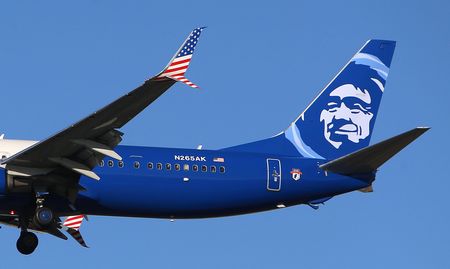By David Shepardson
WASHINGTON (Reuters) -The U.S. Federal Aviation Administration (FAA) has recommended that airlines operating Boeing 737-900ER jets inspect door plugs to ensure that they are properly secured after some operators reported unspecified issues with bolts upon inspections.
Regulators have stepped up scrutiny on Boeing after a Jan. 5 mid-air panel blowout on an eight-week-old Alaska Airlines MAX 9 jet that left a gaping hole in the aircraft. Boeing has sought to contain the damage, appointing an independent advisor to examine quality control in its manufacturing processes while numerous planes remain grounded.
The FAA grounded 171 Boeing 737 MAX 9 planes after the Jan. 5 incident.
In its new “Safety Alert for Operators,” the FAA said that some airlines had conducted additional inspections on the 737-900ER mid-exit door plugs and had noted “findings with bolts during the maintenance inspections.”
The 737-900ER is more widely used than the 737 MAX 9. It is an older model but has the same optional door plug design that allows for the addition of an extra emergency exit door when carriers opt to install more seats.
There are 490 Boeing 737-900ER jets in service, at least 79 of which have an active door rather than the plug because they are operated by low-cost airlines with denser cabins, according to Cirium data.
The FAA recommended that carriers perform key portions of a fuselage plug assembly maintenance procedure related to the four bolts used to secure the door plug to the airframe “as soon as possible.”
A Boeing spokesperson said: “We fully support the FAA and our customers in this action.”
Boeing first delivered the 737-900ER in 2007 and the last one in 2019.
Boeing shares were down 0.8% in morning trading on Monday. They are down more than 17% since the beginning of the year.
Alaska Airlines and United Airlines, the only two U.S. carriers that use the MAX 9, this month said they had found loose parts on multiple grounded MAX 9 aircraft during preliminary checks.
They have had to cancel thousands of flights this month because of the grounding, with United cancellations extending at least through Friday. Alaska did not immediately comment on how long it planned to extend cancellations.
The FAA on Sunday said MAX 9 planes will remain grounded until it “is satisfied they are safe to return to service.”
LITTLE 900ER DISRUPTION SEEN
In contrast to the new MAX 9 that experienced the door-plug issue, Boeing 737-900ER aircraft have more than 11 million hours of operation and 3.9 million flight cycles, and the FAA said the door plug “has not been an issue with this model.”
Both United and Alaska said they had begun inspections of the door plugs on their 737-900ER fleets. United, which has 136 737-900ER aircraft, said inspections should be completed in the next few days without customer disruptions.
Alaska said its inspections began several days ago without any findings so far.
Delta Air Lines, the largest operator of the 900ER, said it had opted to take “proactive measures” to inspect its fleet. It does not expect any operational impact.
Globally, the three U.S. carriers operate the vast majority of the 737-900ERs with the door plugs.
A spokesperson for Korean Air, which has six 737-900ERs, said it planned to carry out additional inspections and finish them within 30 days without any schedule disruption.
The FAA on Wednesday said inspections of an initial group of 40 Boeing 737 MAX 9 jets had been completed, a key hurdle to ending the grounding of the model. The FAA is continuing to review data from those inspections.
FAA Administrator Mike Whitaker told Reuters this month that the FAA was “going through a process to work out how to restore confidence in the integrity of these plug doors.”
National Transportation Safety Board Chair Jennifer Homendy last week said that the investigative agency would be looking at numerous records related to the door plug. She said it was unclear if the bolts on the Alaska Airlines jet were properly secured or if they were actually installed at all.
(Reporting by David Shepardson; Additional reporting by Lisa Barrington, Tim Hepher and Abhijith Ganapavaram; Editing by Edwina Gibbs and David Goodman)

